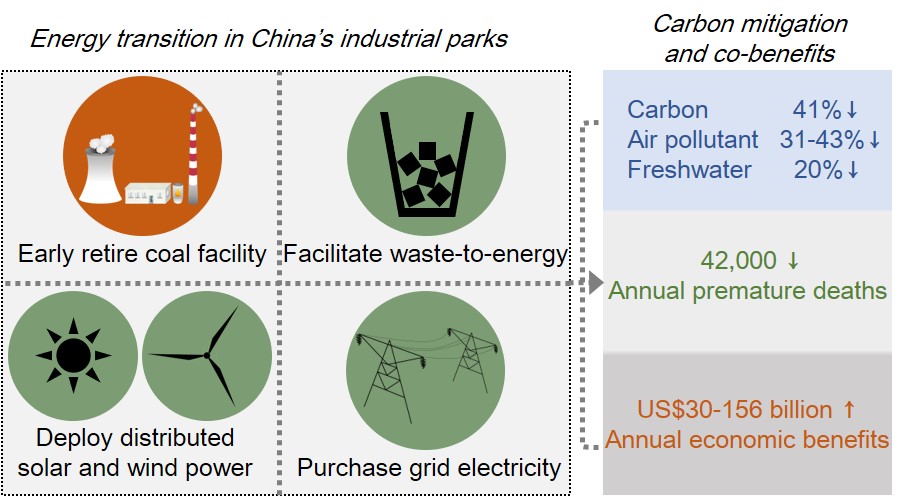Recently, the research team led by Professor Chen Lyujun from the School of Environment at Tsinghua University collaborated with the team led by Denise L. Mauzerall from Princeton University and made significant progress in the field of pollution reduction and carbon mitigation in Chinese industrial parks. In the context of synergistic targets for pollution reduction and carbon mitigation, the joint team reveals that Chinese industrial parks can achieve significant carbon mitigation, water conservation, improvements in air quality, and benefits to human health by promoting the transition to clean energy.
Industrial parks are clusters of industrial production enterprises and hotspots for resource consumption and pollution emissions. As a main carrier for industrial activities, they have been thriving globally. In China, there are currently over 2,500 national and provincial-level industrial parks, contributing to over 50% of the national industrial products, with approximately 30% of the national carbon dioxide emissions. However, systematic analyses for decarbonizing industrial parks at the national level are limited.
This study developed a geodatabase covering energy supply, greenhouse gas emissions, atmospheric pollutants and freshwater consumption for 850 industrial parks in China. By integrating methods such as energy system analyses, a life cycle assessment, air quality simulations, health impact assessment, and cost-benefit analyses, this study quantitatively revealed the carbon mitigation potential, freshwater conservation, air quality improvements, and human health benefits associated with the clean energy transition in industrial parks. The study also identified the technical costs and social benefits resulting from the energy transition. Specific measures for the clean energy transition in industrial parks include: (1) early retirement of coal facilities; (2) promotion of municipal solid waste incineration for heating/power generation; (3) deployment of rooftop photovoltaics and distributed wind power; (4) purchasing grid electricity.

Research framework
This study found that, a clean energy transition for 850 industrial parks in China, compared to the 203- baseline scenario, results in a 41% reduction in greenhouse gas emissions—, equivalent to approximately 6% of the national emissions in 2020. Additionally, reductions in SO2, NOX, and PM2.5 emissions range from 31% to 43%, along with a 20% reduction in freshwater consumption. Using an atmospheric chemistry model with considering parameters such as future changes in population age structure and spatial distribution, the study reveals that the clean energy transition in industrial parks, by reducing ambient PM2.5 and O3 concentrations, could prevent approximately 42,000 premature deaths in 2030. Through a comprehensive analysis encompassing equipment and fuel-related costs as well as monetized benefits of carbon mitigation and human health, the study concluded that the clean energy transition in industrial parks could result in annual net benefits ranging from 0.2 to 1.0 trillion RMB.

Clean Energy Transition Measures in Chinese Industrial Parks and Environmental-Economic Benefits Towards 2030
Industrial parks can effectively manage municipal solid waste in industrial parks and surrounding communities by implementing waste incineration for energy. Deploying rooftop photovoltaic and distributed wind power can fully utilize the inner- and inter-enterprise space . The deployment of microgrids within industrial parks facilitates the local consumption of of low-carbon energy by industrial enterprises. Given the high and stable demand for electricity and heat in industrial parks, deploying low-carbon energy infrastructure promotes self-sufficiency. As industrial parks pay the cost of energy transition technologies, the study suggests subsidies or incentives to industrial parks. This would accelerate nationwide energy transition in industrial parks, achieving larger-scale benefits in carbon mitigation, pollution control, and water conservation. Such initiatives would contribute to the achievement of national goals in climate action, clean air, and water resource management. Pilot programs could be considered in eco-industrial parks, and subsequently to prioritize provinces with a large number of industrial parks for wide applicatoins, such as Shandong, Jiangsu, Zhejiang, and Hebei.
On April 11, this studywas published in Environmental Science & Technology with a title of Carbon Mitigation and Environmental Co-Benefits of a Clean Energy Transition in China’s Industrial Parks. The first author is Guo Yang, a 2019 PhD graduate of the School of Environment, Tsinghua University and an associate research scholar at Princeton University. Chen Lyujun and Denise L. Mauzerall are co-corresponding authors of the paper. Other co-authors include Zhou Mi (a postdoctoral researcher at Princeton), Peng Liqun (a PhD at Princeton and currently a postdoctoral researcher at Lawrence Berkeley National Laboratory), Yang Juhua (a specialist at Electric Power Construction Techno-economic Consulting Center, China Huadian Corporation Ltd), Li Mingwei (a postdoctoral research at Princeton and currently an assistant researcher at the Institute of Energy, Environment, and Economy at Tsinghua University), and Tian Jinping, a professorat the School of Environment,Tsinghua University.
The research team led by Chen Lyujun has long been dedicated to the study and applications of eco-industrial development and industrial parks. They have provided strong scientific support for policymaking by the Ministry of Ecology and Environment, the Ministry of Commerce, the Ministry of Science and Technology, the Ministry of Industry and Information Technology of the People’s Republic of China, and other relevant policy agencies. The team led by Denise L. Mauzerall has been engaged in co-benefits of China's clean air and low carbon policies on air quality, public health, water resources, agriculture, climate, etc.. This research was funded by the National Natural Science Foundation of China, the Princeton University research fund, and the Schmidt Science Fellows program.
Link to the paper: https://pubs.acs.org/doi/10.1021/acs.est.2c05725
Contributed by: Institute of Environmental Biology Education and Research.





